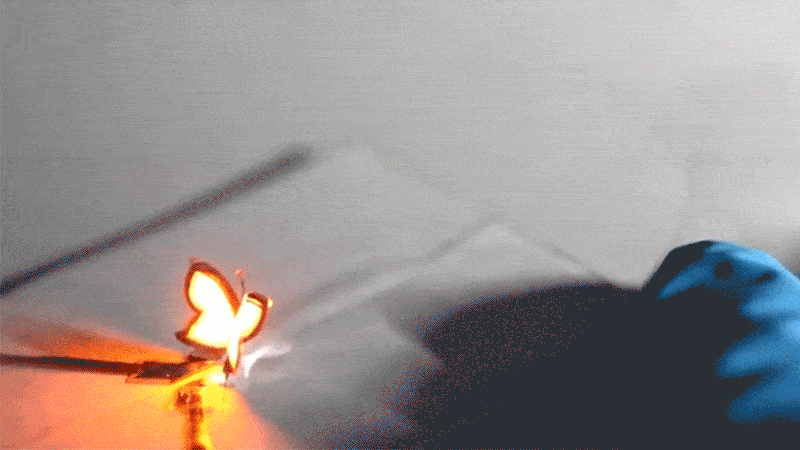Pop-up greeting cards are about to get a whole lot more interesting. Researchers at Seoul National University in Korea have created glowing 3D objects with a series of prototypes that fold thin QLED (Quantum Dot LED) sheets like origami. They used a CO2 laser to etch “fold lines” in the QLED so the sheets could be formed into 3D shapes. The bends are actually rounded, but at 5μm they appear to be sharp corners and the panels continue to illuminate across the fold lines for at least 500 folds. Some glow in solid colors, while others use smaller addressable areas to create animated matrix displays of patterns and letterforms. See the short video after the break, read the Physics World article or to see all the prototypes and dig into details of the full research paper in Nature (freed from the paywall by SharedIt).
We’re not sure how soon this technique can be duplicated in our home labs, but we can’t wait to fold up our own 3D lights and matrices. Until then, check out some glowing origami you can make right now from [Charlyn Gonda] at Remoticon 2020 and earlier that year and this amazing origami lamp.


















I’m not certain what the applications for discrete QLEDs that can be bent a few hundred times would be (though I assume they’ll be apparent at some point) but if the output is homogenous enough it could eliminate the need to have a non-flat diffuser and either edge-lighting or a throw distance in many applications.
That’s really neat and I hope it becomes accessible to manufacturers and product designers soon.
Pop-up books. Greeting cards. Advertising mailers. Business cards.
Ahhh,, more e-waste, just what the world needs.
Don’t get me wrong, the tech is awesome, someone’s going find a super-cheap way to put this on a creating card and it will be enjoyed a dozen times, then deposited in the circular file. By the thousands.
Landfills don’t just fill themselves up you know…
A cloak blanket like harry Potter used to have would also be possible ;-)
I have used those LED strips for Halloween and Christmas lighting (multi color and patterns)
A friend of mine uses them for accent lighting in his kitchen ( under cabinet )
I could see these in a strip form with left and right corner connectors or a flexible type.
Granted I have no idea of how much power it takes and cost.
They last a lot longer than 500 folds – I’ve kept this page open all day, and the one at the top is still working!
Don’t be silly, you are supposed to fold the webpage 500 times :P
And that’s just your views! Imagine how many people are doing the same thing.
Will someone please think of the folding butterflies!?
Please remove the GIF from this web page. The butterfly effect is creating snow here, and I don’t want to have to clear off my car.
Interesting application of the tech. Of course, it is already possible to make pop up cards with integrated electronics and lights in a home lab/studio:
https://evermorestud.io/garden-lantern-pop-up-card-with-integrated-electr
So, the novelty here isn’t in the OLED or QLED electroluminescent material — it’s in the laser-etch-aided folding.
It seems like the low-poly papercraft folks should be all over this, using the readily-available and cheap “conventional” electroluminescent sheet material: $10/sq ft, in all colors of the rainbow, from your favorite back Ali-Bay.
Sort out the required fold/etch patterns, pop it in the glowforge (or cricut, for that matter) for a few minutes and poof! — Instant 3-D glowing structure.
When you tire of feeding 12V to the power supply for those sheets and want to migrate to the 5V the OLED/QLED material drinks, I’m sure they’ll be available from the usual sources too.
I’m sure, in time, they will have figured out how to avoid using super-toxic nanoscale cadmium and other heavy metals in Q-dots. Graphene will save us, I hear.
I can see this going really neatly for some more practical projects with the Polysense stuff I learned about here (and still haven’t managed to get around to trying). Flexible fabric sensors and backings for the semi-flexible output and such…
Not sure if this method really has legs though – just how repeatable and consistent is the folding longevity (which the manufacturing process, all the possible material sources, and the shapes formed are bound to influence heavily), and also does the folding process even if its into a fixed object cause enough stress the thermal cycling etc of the real world will kill it quicker too – if you want a lightweight shaped light for something this seems ideal, unless it needs replacing many times more often..
It does look great, and could be very useful I really hope the method can be really well quantified so poor folks like me can just order the amount we need not 6 months of R&D to get the result to stay stable in the ‘finished’ thingymi we were working on…
I understand you so perfectly, I also in school had problems with macroeconomics, it seems to me a difficult subject that should not be imposed on every schoolchild, for me it was saving this source https://papersowl.com/examples/macroeconomics/ because there I found answers to many questions that were not clear to me, if you also have problems with it then I recommend you to read!